Business Law Assignment: Analysis of Corporations Act and Share Sales
VerifiedAdded on 2020/04/07
|12
|3088
|56
Report
AI Summary
This report analyzes the case of Fame Decorator Agencies Pty Limited v Jefferies Industries Limited, focusing on the contravention of sections 995 and 998 of the Corporations Act regarding the sale of shares. The appellant, Fame, was found to have engaged in misleading and deceptive conduct by selling shares in a manner that artificially lowered the market price. The court examined the actions of Mr. O'Halloran, who controlled Fame, and determined that his conduct was aimed at manipulating the market. The analysis includes a critical examination of the majority decision, which found that Fame breached the Act, and a dissenting judgment which argued that the appellant was simply acting to obtain financial advantage within the existing market procedures. The report delves into the legal arguments, including the application of section 998 to protect market integrity and section 995 to prevent misleading conduct, as well as the impact of the case on the share market and the interpretation of genuine supply and demand. The dissenting judgment highlights the complexities of the case and the challenges in determining whether the appellant's actions constituted manipulative behavior.
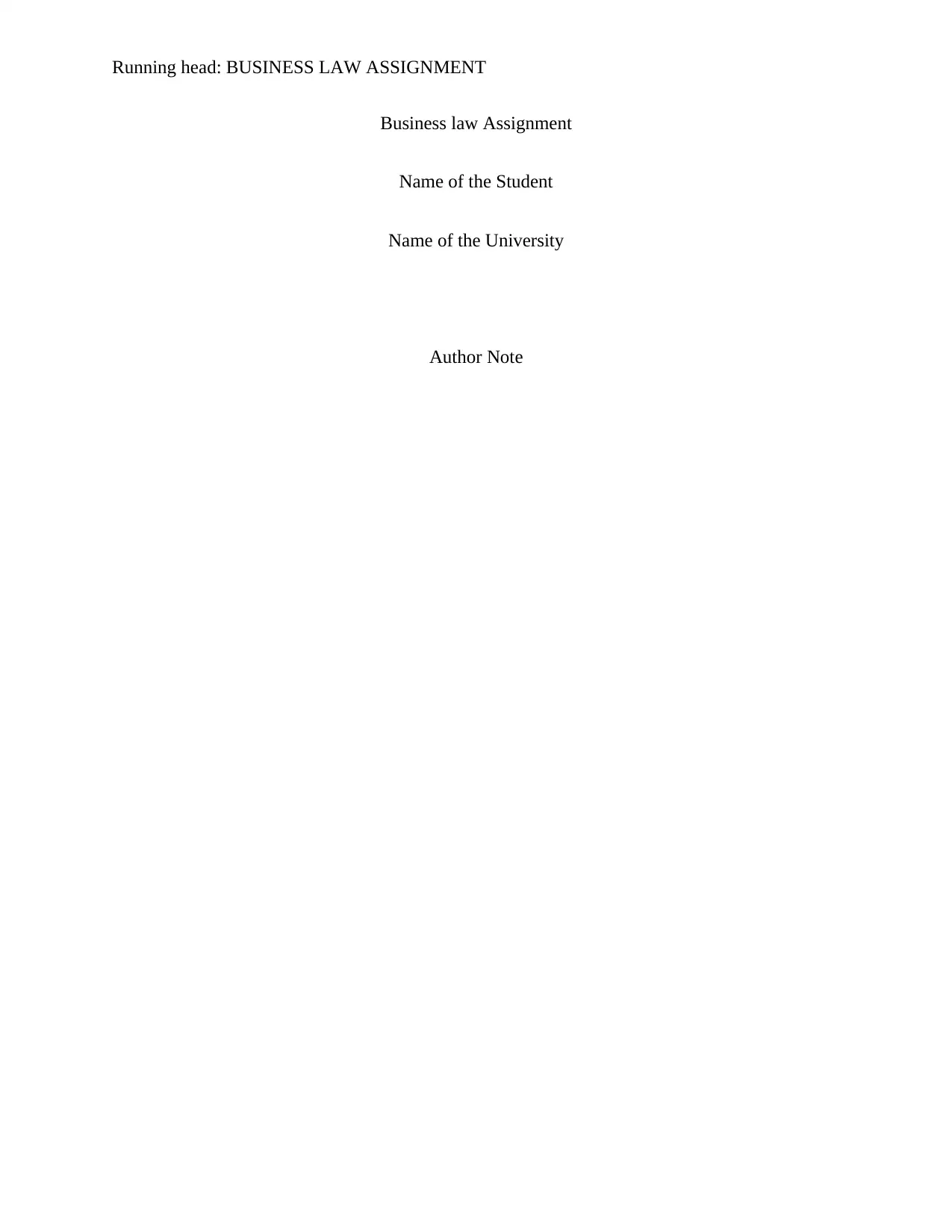
Running head: BUSINESS LAW ASSIGNMENT
Business law Assignment
Name of the Student
Name of the University
Author Note
Business law Assignment
Name of the Student
Name of the University
Author Note
Paraphrase This Document
Need a fresh take? Get an instant paraphrase of this document with our AI Paraphraser
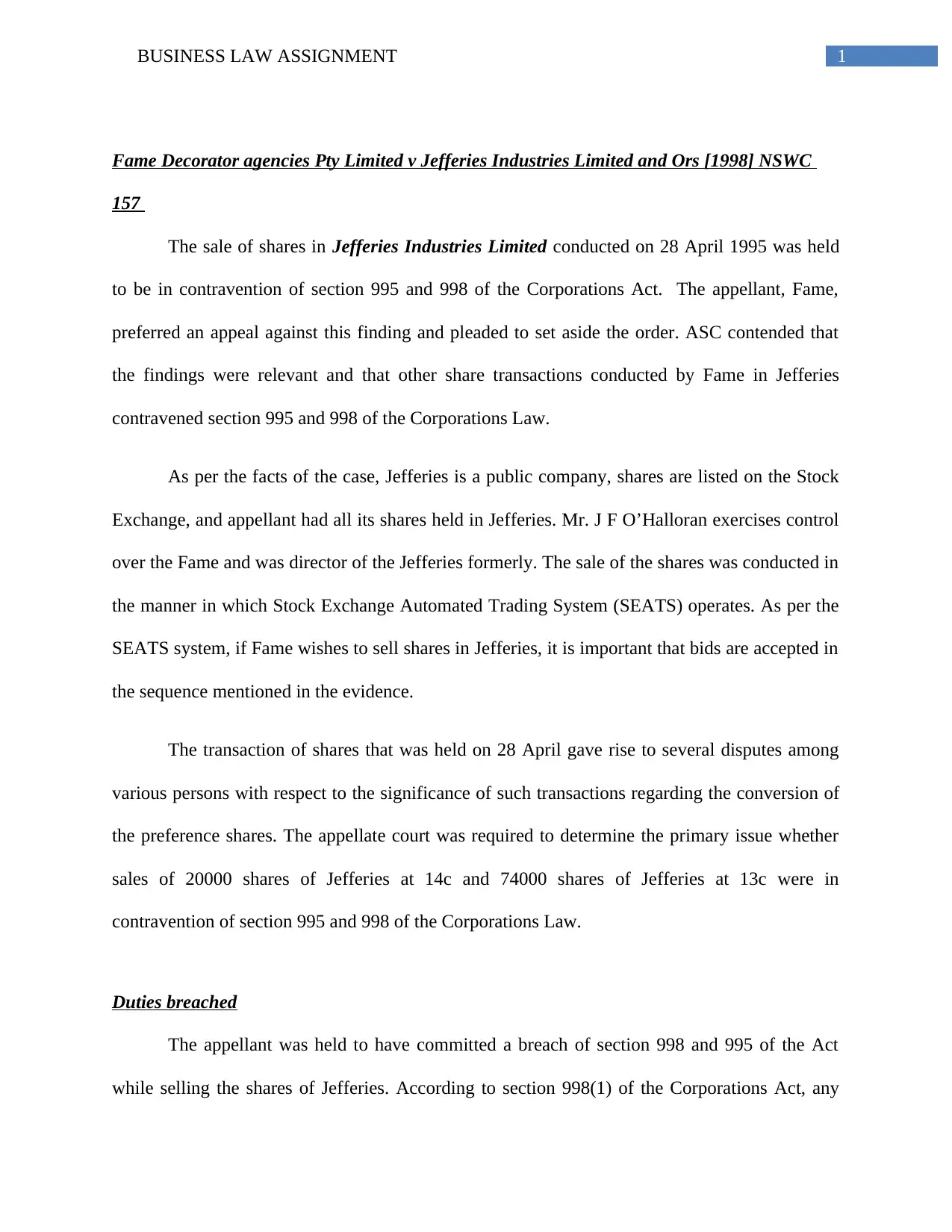
1BUSINESS LAW ASSIGNMENT
Fame Decorator agencies Pty Limited v Jefferies Industries Limited and Ors [1998] NSWC
157
The sale of shares in Jefferies Industries Limited conducted on 28 April 1995 was held
to be in contravention of section 995 and 998 of the Corporations Act. The appellant, Fame,
preferred an appeal against this finding and pleaded to set aside the order. ASC contended that
the findings were relevant and that other share transactions conducted by Fame in Jefferies
contravened section 995 and 998 of the Corporations Law.
As per the facts of the case, Jefferies is a public company, shares are listed on the Stock
Exchange, and appellant had all its shares held in Jefferies. Mr. J F O’Halloran exercises control
over the Fame and was director of the Jefferies formerly. The sale of the shares was conducted in
the manner in which Stock Exchange Automated Trading System (SEATS) operates. As per the
SEATS system, if Fame wishes to sell shares in Jefferies, it is important that bids are accepted in
the sequence mentioned in the evidence.
The transaction of shares that was held on 28 April gave rise to several disputes among
various persons with respect to the significance of such transactions regarding the conversion of
the preference shares. The appellate court was required to determine the primary issue whether
sales of 20000 shares of Jefferies at 14c and 74000 shares of Jefferies at 13c were in
contravention of section 995 and 998 of the Corporations Law.
Duties breached
The appellant was held to have committed a breach of section 998 and 995 of the Act
while selling the shares of Jefferies. According to section 998(1) of the Corporations Act, any
Fame Decorator agencies Pty Limited v Jefferies Industries Limited and Ors [1998] NSWC
157
The sale of shares in Jefferies Industries Limited conducted on 28 April 1995 was held
to be in contravention of section 995 and 998 of the Corporations Act. The appellant, Fame,
preferred an appeal against this finding and pleaded to set aside the order. ASC contended that
the findings were relevant and that other share transactions conducted by Fame in Jefferies
contravened section 995 and 998 of the Corporations Law.
As per the facts of the case, Jefferies is a public company, shares are listed on the Stock
Exchange, and appellant had all its shares held in Jefferies. Mr. J F O’Halloran exercises control
over the Fame and was director of the Jefferies formerly. The sale of the shares was conducted in
the manner in which Stock Exchange Automated Trading System (SEATS) operates. As per the
SEATS system, if Fame wishes to sell shares in Jefferies, it is important that bids are accepted in
the sequence mentioned in the evidence.
The transaction of shares that was held on 28 April gave rise to several disputes among
various persons with respect to the significance of such transactions regarding the conversion of
the preference shares. The appellate court was required to determine the primary issue whether
sales of 20000 shares of Jefferies at 14c and 74000 shares of Jefferies at 13c were in
contravention of section 995 and 998 of the Corporations Law.
Duties breached
The appellant was held to have committed a breach of section 998 and 995 of the Act
while selling the shares of Jefferies. According to section 998(1) of the Corporations Act, any
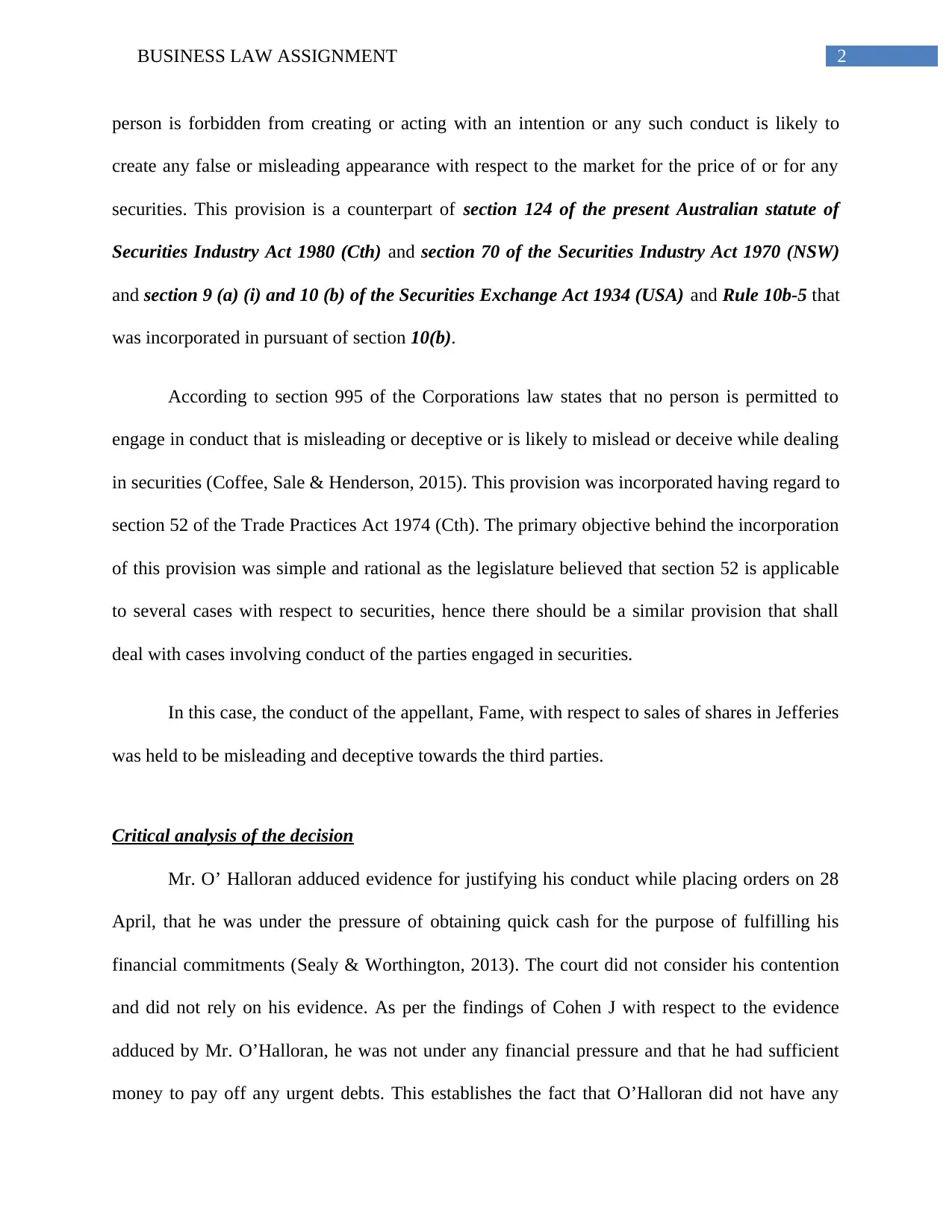
2BUSINESS LAW ASSIGNMENT
person is forbidden from creating or acting with an intention or any such conduct is likely to
create any false or misleading appearance with respect to the market for the price of or for any
securities. This provision is a counterpart of section 124 of the present Australian statute of
Securities Industry Act 1980 (Cth) and section 70 of the Securities Industry Act 1970 (NSW)
and section 9 (a) (i) and 10 (b) of the Securities Exchange Act 1934 (USA) and Rule 10b-5 that
was incorporated in pursuant of section 10(b).
According to section 995 of the Corporations law states that no person is permitted to
engage in conduct that is misleading or deceptive or is likely to mislead or deceive while dealing
in securities (Coffee, Sale & Henderson, 2015). This provision was incorporated having regard to
section 52 of the Trade Practices Act 1974 (Cth). The primary objective behind the incorporation
of this provision was simple and rational as the legislature believed that section 52 is applicable
to several cases with respect to securities, hence there should be a similar provision that shall
deal with cases involving conduct of the parties engaged in securities.
In this case, the conduct of the appellant, Fame, with respect to sales of shares in Jefferies
was held to be misleading and deceptive towards the third parties.
Critical analysis of the decision
Mr. O’ Halloran adduced evidence for justifying his conduct while placing orders on 28
April, that he was under the pressure of obtaining quick cash for the purpose of fulfilling his
financial commitments (Sealy & Worthington, 2013). The court did not consider his contention
and did not rely on his evidence. As per the findings of Cohen J with respect to the evidence
adduced by Mr. O’Halloran, he was not under any financial pressure and that he had sufficient
money to pay off any urgent debts. This establishes the fact that O’Halloran did not have any
person is forbidden from creating or acting with an intention or any such conduct is likely to
create any false or misleading appearance with respect to the market for the price of or for any
securities. This provision is a counterpart of section 124 of the present Australian statute of
Securities Industry Act 1980 (Cth) and section 70 of the Securities Industry Act 1970 (NSW)
and section 9 (a) (i) and 10 (b) of the Securities Exchange Act 1934 (USA) and Rule 10b-5 that
was incorporated in pursuant of section 10(b).
According to section 995 of the Corporations law states that no person is permitted to
engage in conduct that is misleading or deceptive or is likely to mislead or deceive while dealing
in securities (Coffee, Sale & Henderson, 2015). This provision was incorporated having regard to
section 52 of the Trade Practices Act 1974 (Cth). The primary objective behind the incorporation
of this provision was simple and rational as the legislature believed that section 52 is applicable
to several cases with respect to securities, hence there should be a similar provision that shall
deal with cases involving conduct of the parties engaged in securities.
In this case, the conduct of the appellant, Fame, with respect to sales of shares in Jefferies
was held to be misleading and deceptive towards the third parties.
Critical analysis of the decision
Mr. O’ Halloran adduced evidence for justifying his conduct while placing orders on 28
April, that he was under the pressure of obtaining quick cash for the purpose of fulfilling his
financial commitments (Sealy & Worthington, 2013). The court did not consider his contention
and did not rely on his evidence. As per the findings of Cohen J with respect to the evidence
adduced by Mr. O’Halloran, he was not under any financial pressure and that he had sufficient
money to pay off any urgent debts. This establishes the fact that O’Halloran did not have any
⊘ This is a preview!⊘
Do you want full access?
Subscribe today to unlock all pages.

Trusted by 1+ million students worldwide
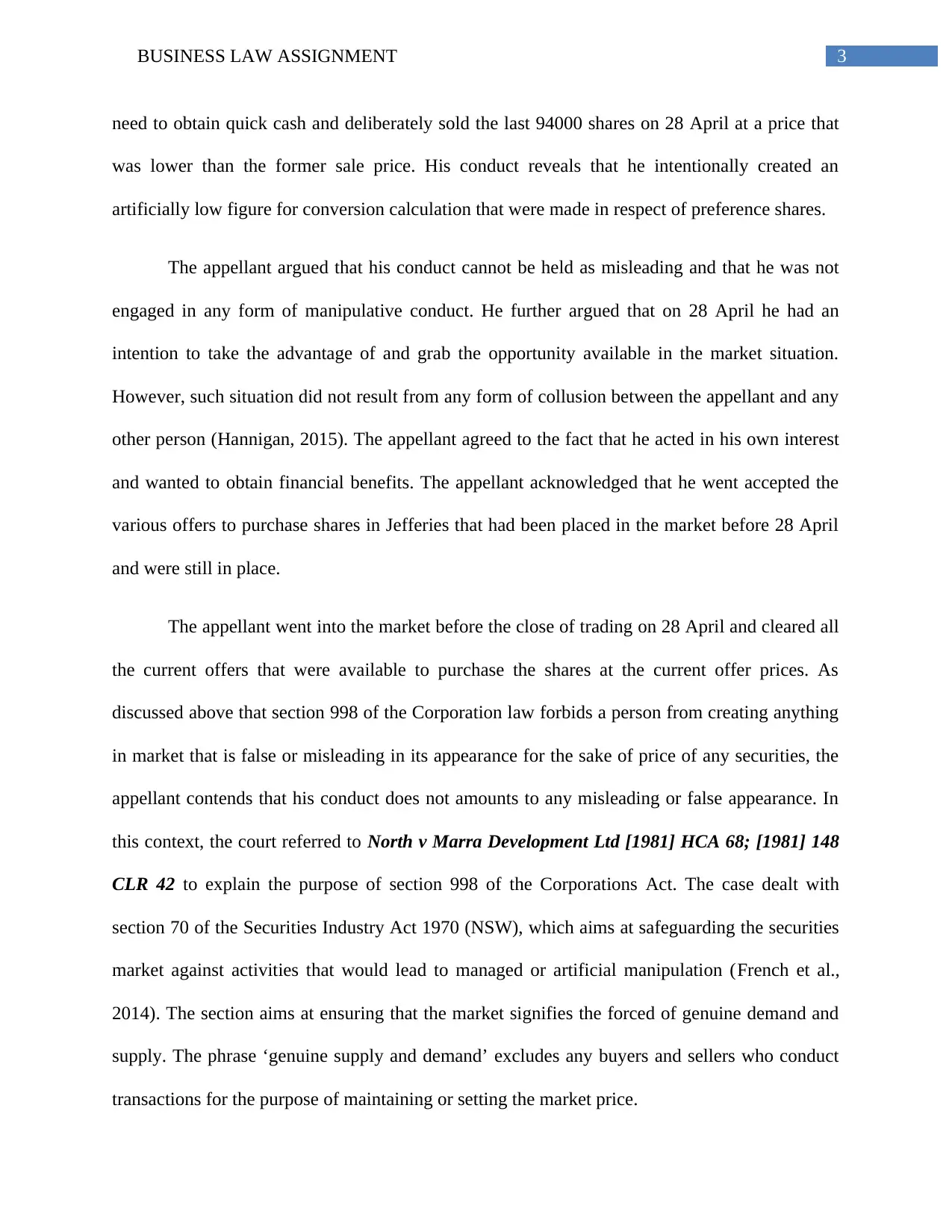
3BUSINESS LAW ASSIGNMENT
need to obtain quick cash and deliberately sold the last 94000 shares on 28 April at a price that
was lower than the former sale price. His conduct reveals that he intentionally created an
artificially low figure for conversion calculation that were made in respect of preference shares.
The appellant argued that his conduct cannot be held as misleading and that he was not
engaged in any form of manipulative conduct. He further argued that on 28 April he had an
intention to take the advantage of and grab the opportunity available in the market situation.
However, such situation did not result from any form of collusion between the appellant and any
other person (Hannigan, 2015). The appellant agreed to the fact that he acted in his own interest
and wanted to obtain financial benefits. The appellant acknowledged that he went accepted the
various offers to purchase shares in Jefferies that had been placed in the market before 28 April
and were still in place.
The appellant went into the market before the close of trading on 28 April and cleared all
the current offers that were available to purchase the shares at the current offer prices. As
discussed above that section 998 of the Corporation law forbids a person from creating anything
in market that is false or misleading in its appearance for the sake of price of any securities, the
appellant contends that his conduct does not amounts to any misleading or false appearance. In
this context, the court referred to North v Marra Development Ltd [1981] HCA 68; [1981] 148
CLR 42 to explain the purpose of section 998 of the Corporations Act. The case dealt with
section 70 of the Securities Industry Act 1970 (NSW), which aims at safeguarding the securities
market against activities that would lead to managed or artificial manipulation (French et al.,
2014). The section aims at ensuring that the market signifies the forced of genuine demand and
supply. The phrase ‘genuine supply and demand’ excludes any buyers and sellers who conduct
transactions for the purpose of maintaining or setting the market price.
need to obtain quick cash and deliberately sold the last 94000 shares on 28 April at a price that
was lower than the former sale price. His conduct reveals that he intentionally created an
artificially low figure for conversion calculation that were made in respect of preference shares.
The appellant argued that his conduct cannot be held as misleading and that he was not
engaged in any form of manipulative conduct. He further argued that on 28 April he had an
intention to take the advantage of and grab the opportunity available in the market situation.
However, such situation did not result from any form of collusion between the appellant and any
other person (Hannigan, 2015). The appellant agreed to the fact that he acted in his own interest
and wanted to obtain financial benefits. The appellant acknowledged that he went accepted the
various offers to purchase shares in Jefferies that had been placed in the market before 28 April
and were still in place.
The appellant went into the market before the close of trading on 28 April and cleared all
the current offers that were available to purchase the shares at the current offer prices. As
discussed above that section 998 of the Corporation law forbids a person from creating anything
in market that is false or misleading in its appearance for the sake of price of any securities, the
appellant contends that his conduct does not amounts to any misleading or false appearance. In
this context, the court referred to North v Marra Development Ltd [1981] HCA 68; [1981] 148
CLR 42 to explain the purpose of section 998 of the Corporations Act. The case dealt with
section 70 of the Securities Industry Act 1970 (NSW), which aims at safeguarding the securities
market against activities that would lead to managed or artificial manipulation (French et al.,
2014). The section aims at ensuring that the market signifies the forced of genuine demand and
supply. The phrase ‘genuine supply and demand’ excludes any buyers and sellers who conduct
transactions for the purpose of maintaining or setting the market price.
Paraphrase This Document
Need a fresh take? Get an instant paraphrase of this document with our AI Paraphraser
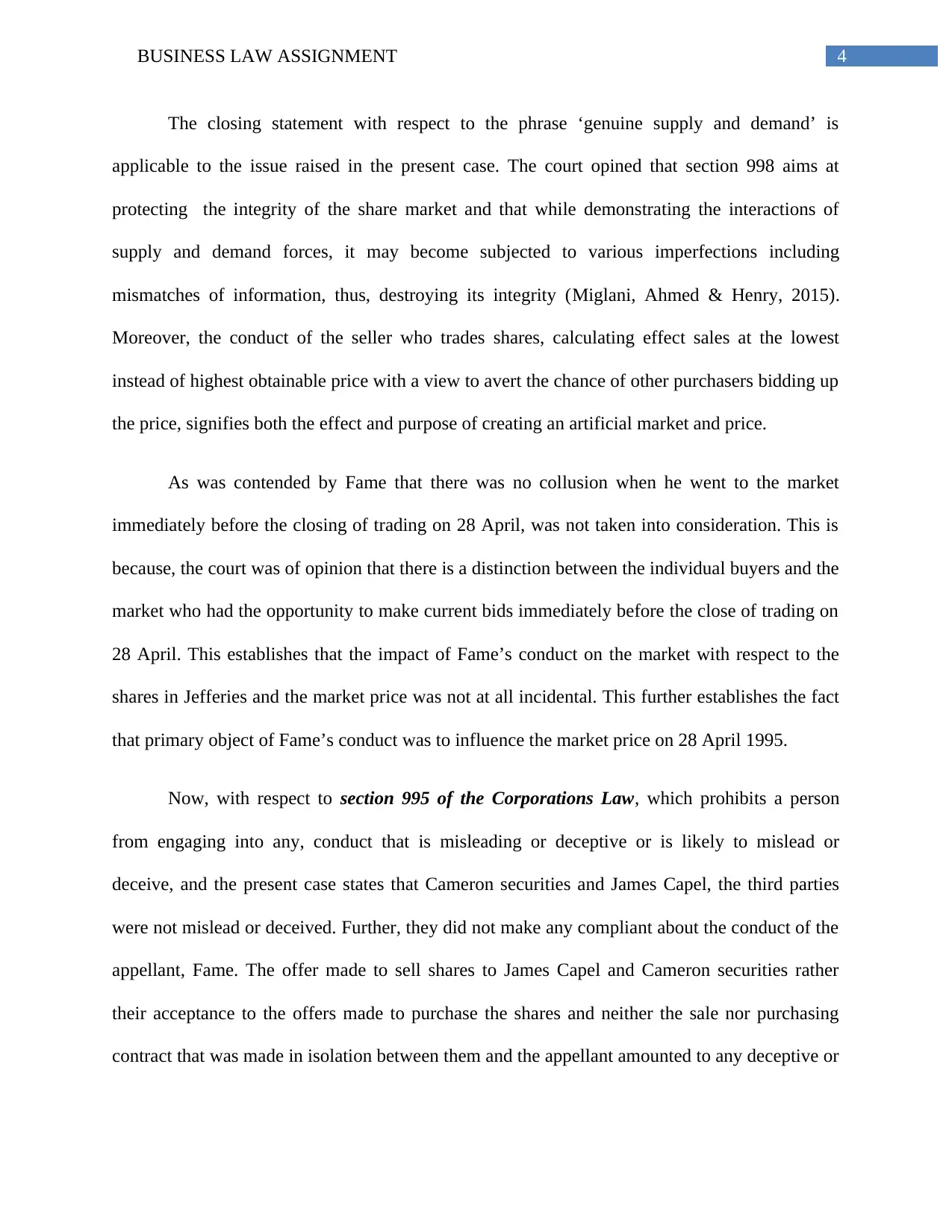
4BUSINESS LAW ASSIGNMENT
The closing statement with respect to the phrase ‘genuine supply and demand’ is
applicable to the issue raised in the present case. The court opined that section 998 aims at
protecting the integrity of the share market and that while demonstrating the interactions of
supply and demand forces, it may become subjected to various imperfections including
mismatches of information, thus, destroying its integrity (Miglani, Ahmed & Henry, 2015).
Moreover, the conduct of the seller who trades shares, calculating effect sales at the lowest
instead of highest obtainable price with a view to avert the chance of other purchasers bidding up
the price, signifies both the effect and purpose of creating an artificial market and price.
As was contended by Fame that there was no collusion when he went to the market
immediately before the closing of trading on 28 April, was not taken into consideration. This is
because, the court was of opinion that there is a distinction between the individual buyers and the
market who had the opportunity to make current bids immediately before the close of trading on
28 April. This establishes that the impact of Fame’s conduct on the market with respect to the
shares in Jefferies and the market price was not at all incidental. This further establishes the fact
that primary object of Fame’s conduct was to influence the market price on 28 April 1995.
Now, with respect to section 995 of the Corporations Law, which prohibits a person
from engaging into any, conduct that is misleading or deceptive or is likely to mislead or
deceive, and the present case states that Cameron securities and James Capel, the third parties
were not mislead or deceived. Further, they did not make any compliant about the conduct of the
appellant, Fame. The offer made to sell shares to James Capel and Cameron securities rather
their acceptance to the offers made to purchase the shares and neither the sale nor purchasing
contract that was made in isolation between them and the appellant amounted to any deceptive or
The closing statement with respect to the phrase ‘genuine supply and demand’ is
applicable to the issue raised in the present case. The court opined that section 998 aims at
protecting the integrity of the share market and that while demonstrating the interactions of
supply and demand forces, it may become subjected to various imperfections including
mismatches of information, thus, destroying its integrity (Miglani, Ahmed & Henry, 2015).
Moreover, the conduct of the seller who trades shares, calculating effect sales at the lowest
instead of highest obtainable price with a view to avert the chance of other purchasers bidding up
the price, signifies both the effect and purpose of creating an artificial market and price.
As was contended by Fame that there was no collusion when he went to the market
immediately before the closing of trading on 28 April, was not taken into consideration. This is
because, the court was of opinion that there is a distinction between the individual buyers and the
market who had the opportunity to make current bids immediately before the close of trading on
28 April. This establishes that the impact of Fame’s conduct on the market with respect to the
shares in Jefferies and the market price was not at all incidental. This further establishes the fact
that primary object of Fame’s conduct was to influence the market price on 28 April 1995.
Now, with respect to section 995 of the Corporations Law, which prohibits a person
from engaging into any, conduct that is misleading or deceptive or is likely to mislead or
deceive, and the present case states that Cameron securities and James Capel, the third parties
were not mislead or deceived. Further, they did not make any compliant about the conduct of the
appellant, Fame. The offer made to sell shares to James Capel and Cameron securities rather
their acceptance to the offers made to purchase the shares and neither the sale nor purchasing
contract that was made in isolation between them and the appellant amounted to any deceptive or
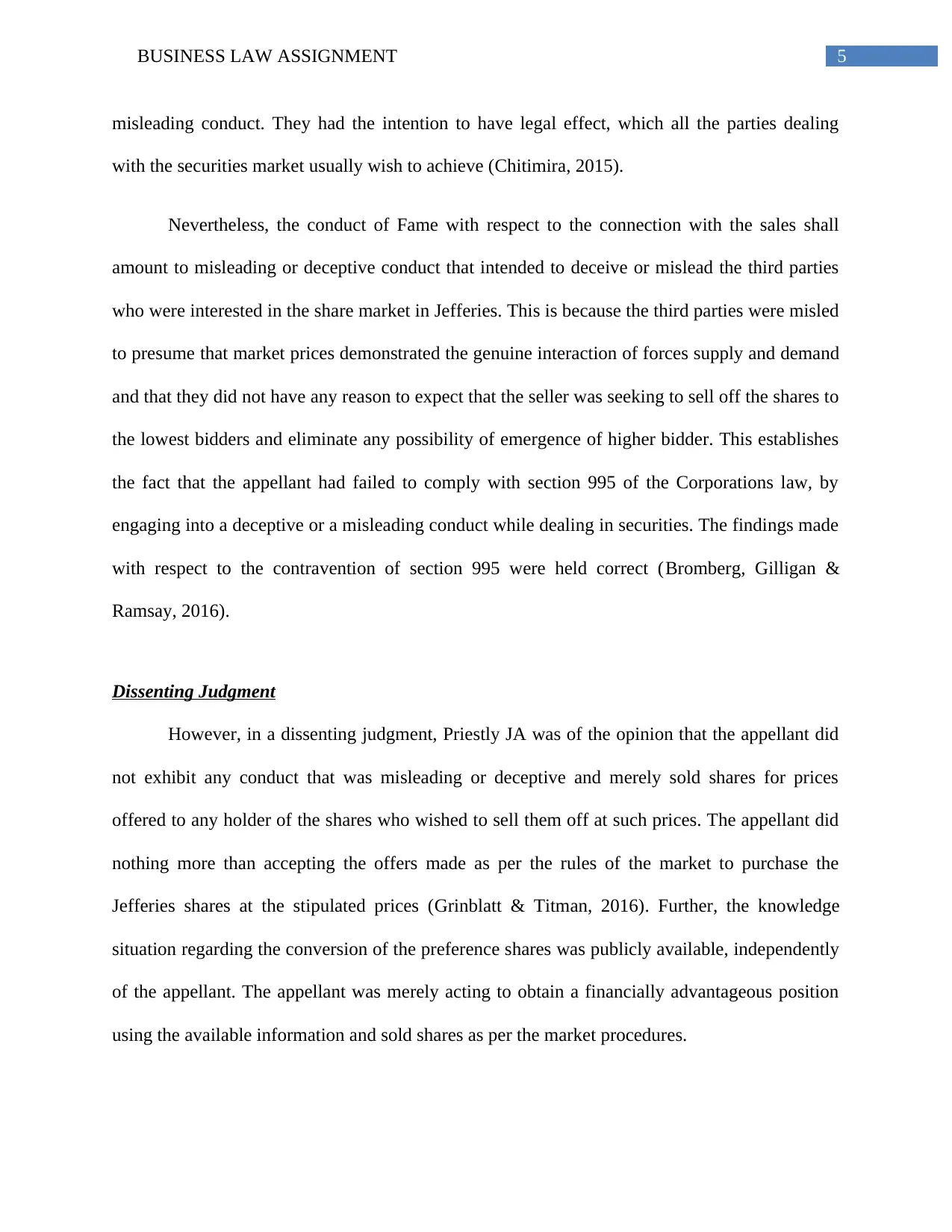
5BUSINESS LAW ASSIGNMENT
misleading conduct. They had the intention to have legal effect, which all the parties dealing
with the securities market usually wish to achieve (Chitimira, 2015).
Nevertheless, the conduct of Fame with respect to the connection with the sales shall
amount to misleading or deceptive conduct that intended to deceive or mislead the third parties
who were interested in the share market in Jefferies. This is because the third parties were misled
to presume that market prices demonstrated the genuine interaction of forces supply and demand
and that they did not have any reason to expect that the seller was seeking to sell off the shares to
the lowest bidders and eliminate any possibility of emergence of higher bidder. This establishes
the fact that the appellant had failed to comply with section 995 of the Corporations law, by
engaging into a deceptive or a misleading conduct while dealing in securities. The findings made
with respect to the contravention of section 995 were held correct (Bromberg, Gilligan &
Ramsay, 2016).
Dissenting Judgment
However, in a dissenting judgment, Priestly JA was of the opinion that the appellant did
not exhibit any conduct that was misleading or deceptive and merely sold shares for prices
offered to any holder of the shares who wished to sell them off at such prices. The appellant did
nothing more than accepting the offers made as per the rules of the market to purchase the
Jefferies shares at the stipulated prices (Grinblatt & Titman, 2016). Further, the knowledge
situation regarding the conversion of the preference shares was publicly available, independently
of the appellant. The appellant was merely acting to obtain a financially advantageous position
using the available information and sold shares as per the market procedures.
misleading conduct. They had the intention to have legal effect, which all the parties dealing
with the securities market usually wish to achieve (Chitimira, 2015).
Nevertheless, the conduct of Fame with respect to the connection with the sales shall
amount to misleading or deceptive conduct that intended to deceive or mislead the third parties
who were interested in the share market in Jefferies. This is because the third parties were misled
to presume that market prices demonstrated the genuine interaction of forces supply and demand
and that they did not have any reason to expect that the seller was seeking to sell off the shares to
the lowest bidders and eliminate any possibility of emergence of higher bidder. This establishes
the fact that the appellant had failed to comply with section 995 of the Corporations law, by
engaging into a deceptive or a misleading conduct while dealing in securities. The findings made
with respect to the contravention of section 995 were held correct (Bromberg, Gilligan &
Ramsay, 2016).
Dissenting Judgment
However, in a dissenting judgment, Priestly JA was of the opinion that the appellant did
not exhibit any conduct that was misleading or deceptive and merely sold shares for prices
offered to any holder of the shares who wished to sell them off at such prices. The appellant did
nothing more than accepting the offers made as per the rules of the market to purchase the
Jefferies shares at the stipulated prices (Grinblatt & Titman, 2016). Further, the knowledge
situation regarding the conversion of the preference shares was publicly available, independently
of the appellant. The appellant was merely acting to obtain a financially advantageous position
using the available information and sold shares as per the market procedures.
⊘ This is a preview!⊘
Do you want full access?
Subscribe today to unlock all pages.

Trusted by 1+ million students worldwide
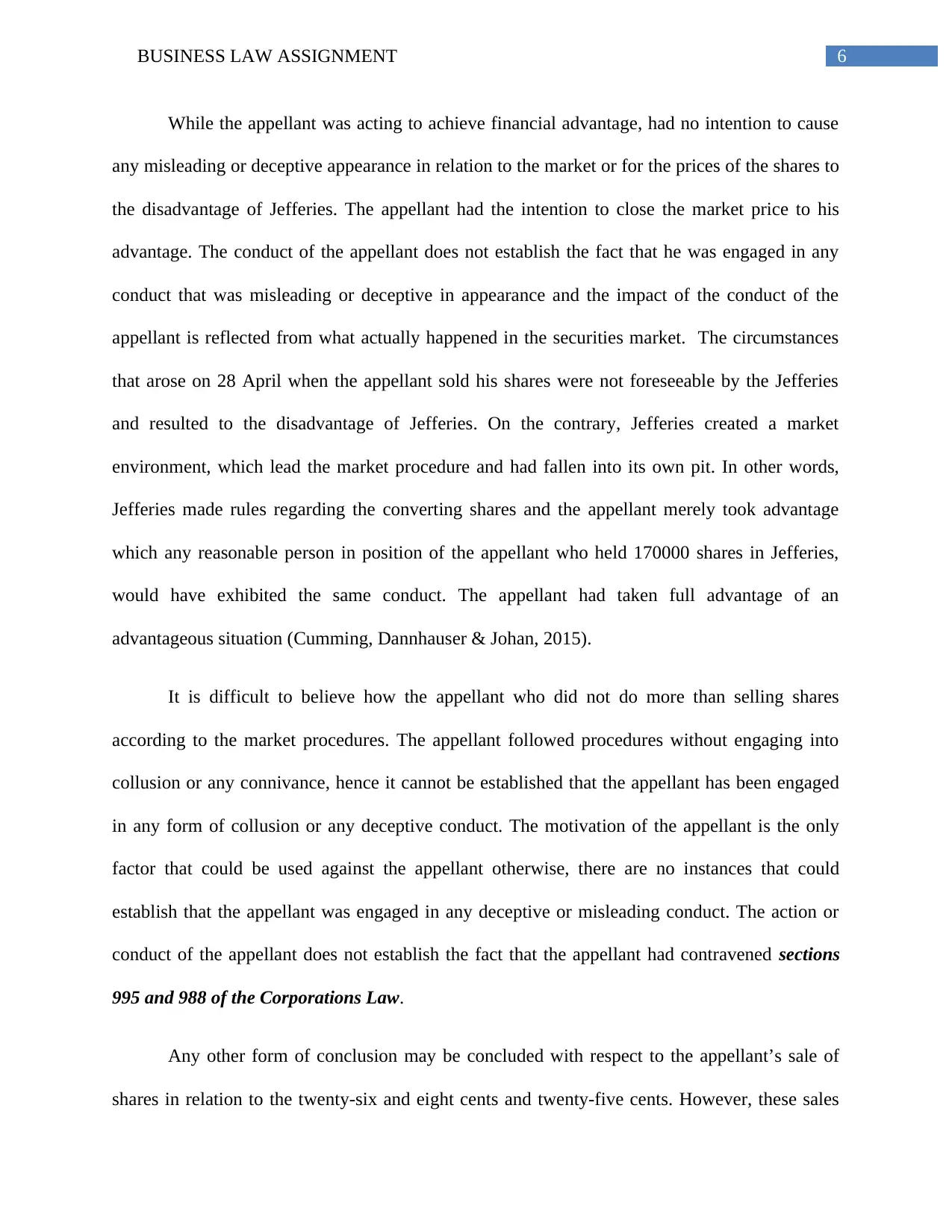
6BUSINESS LAW ASSIGNMENT
While the appellant was acting to achieve financial advantage, had no intention to cause
any misleading or deceptive appearance in relation to the market or for the prices of the shares to
the disadvantage of Jefferies. The appellant had the intention to close the market price to his
advantage. The conduct of the appellant does not establish the fact that he was engaged in any
conduct that was misleading or deceptive in appearance and the impact of the conduct of the
appellant is reflected from what actually happened in the securities market. The circumstances
that arose on 28 April when the appellant sold his shares were not foreseeable by the Jefferies
and resulted to the disadvantage of Jefferies. On the contrary, Jefferies created a market
environment, which lead the market procedure and had fallen into its own pit. In other words,
Jefferies made rules regarding the converting shares and the appellant merely took advantage
which any reasonable person in position of the appellant who held 170000 shares in Jefferies,
would have exhibited the same conduct. The appellant had taken full advantage of an
advantageous situation (Cumming, Dannhauser & Johan, 2015).
It is difficult to believe how the appellant who did not do more than selling shares
according to the market procedures. The appellant followed procedures without engaging into
collusion or any connivance, hence it cannot be established that the appellant has been engaged
in any form of collusion or any deceptive conduct. The motivation of the appellant is the only
factor that could be used against the appellant otherwise, there are no instances that could
establish that the appellant was engaged in any deceptive or misleading conduct. The action or
conduct of the appellant does not establish the fact that the appellant had contravened sections
995 and 988 of the Corporations Law.
Any other form of conclusion may be concluded with respect to the appellant’s sale of
shares in relation to the twenty-six and eight cents and twenty-five cents. However, these sales
While the appellant was acting to achieve financial advantage, had no intention to cause
any misleading or deceptive appearance in relation to the market or for the prices of the shares to
the disadvantage of Jefferies. The appellant had the intention to close the market price to his
advantage. The conduct of the appellant does not establish the fact that he was engaged in any
conduct that was misleading or deceptive in appearance and the impact of the conduct of the
appellant is reflected from what actually happened in the securities market. The circumstances
that arose on 28 April when the appellant sold his shares were not foreseeable by the Jefferies
and resulted to the disadvantage of Jefferies. On the contrary, Jefferies created a market
environment, which lead the market procedure and had fallen into its own pit. In other words,
Jefferies made rules regarding the converting shares and the appellant merely took advantage
which any reasonable person in position of the appellant who held 170000 shares in Jefferies,
would have exhibited the same conduct. The appellant had taken full advantage of an
advantageous situation (Cumming, Dannhauser & Johan, 2015).
It is difficult to believe how the appellant who did not do more than selling shares
according to the market procedures. The appellant followed procedures without engaging into
collusion or any connivance, hence it cannot be established that the appellant has been engaged
in any form of collusion or any deceptive conduct. The motivation of the appellant is the only
factor that could be used against the appellant otherwise, there are no instances that could
establish that the appellant was engaged in any deceptive or misleading conduct. The action or
conduct of the appellant does not establish the fact that the appellant had contravened sections
995 and 988 of the Corporations Law.
Any other form of conclusion may be concluded with respect to the appellant’s sale of
shares in relation to the twenty-six and eight cents and twenty-five cents. However, these sales
Paraphrase This Document
Need a fresh take? Get an instant paraphrase of this document with our AI Paraphraser
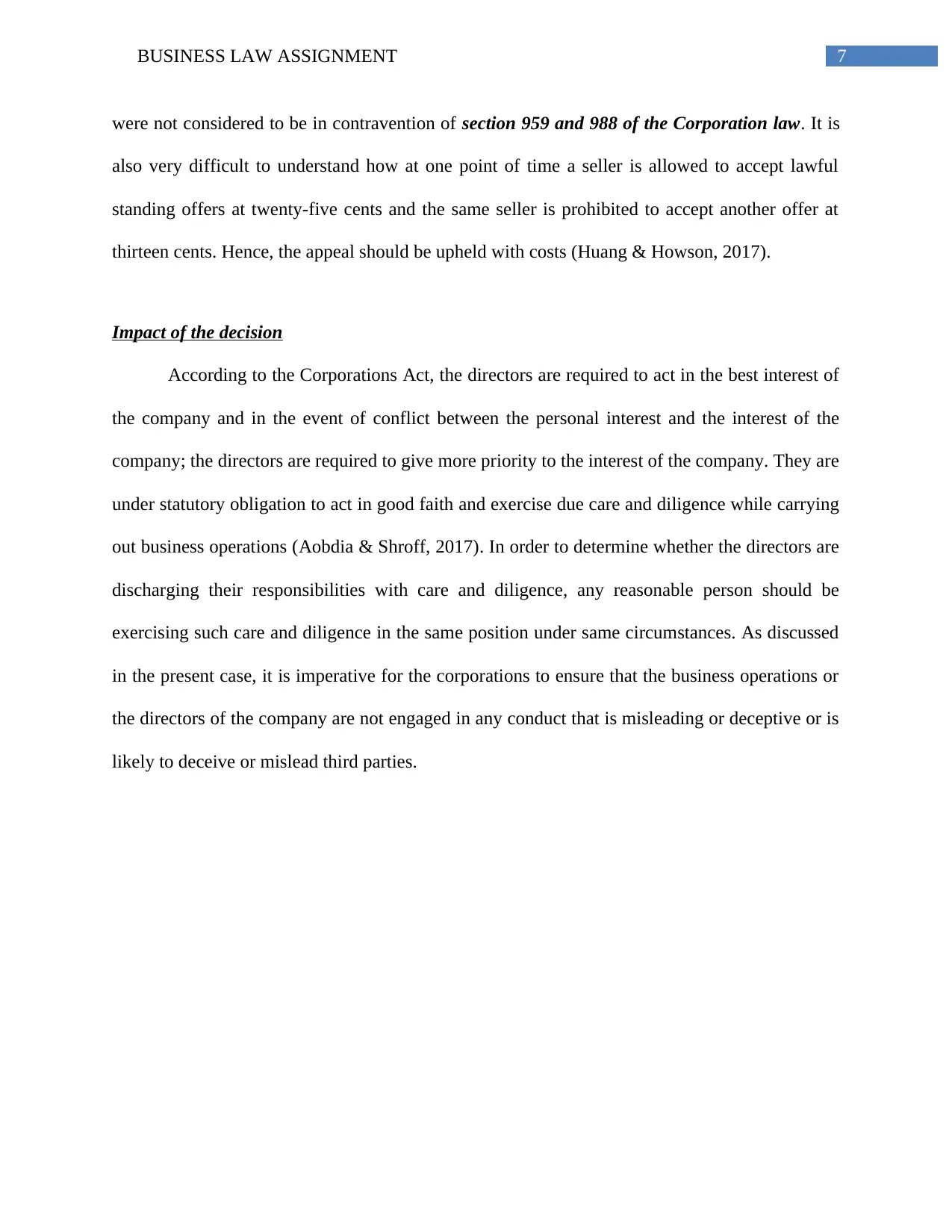
7BUSINESS LAW ASSIGNMENT
were not considered to be in contravention of section 959 and 988 of the Corporation law. It is
also very difficult to understand how at one point of time a seller is allowed to accept lawful
standing offers at twenty-five cents and the same seller is prohibited to accept another offer at
thirteen cents. Hence, the appeal should be upheld with costs (Huang & Howson, 2017).
Impact of the decision
According to the Corporations Act, the directors are required to act in the best interest of
the company and in the event of conflict between the personal interest and the interest of the
company; the directors are required to give more priority to the interest of the company. They are
under statutory obligation to act in good faith and exercise due care and diligence while carrying
out business operations (Aobdia & Shroff, 2017). In order to determine whether the directors are
discharging their responsibilities with care and diligence, any reasonable person should be
exercising such care and diligence in the same position under same circumstances. As discussed
in the present case, it is imperative for the corporations to ensure that the business operations or
the directors of the company are not engaged in any conduct that is misleading or deceptive or is
likely to deceive or mislead third parties.
were not considered to be in contravention of section 959 and 988 of the Corporation law. It is
also very difficult to understand how at one point of time a seller is allowed to accept lawful
standing offers at twenty-five cents and the same seller is prohibited to accept another offer at
thirteen cents. Hence, the appeal should be upheld with costs (Huang & Howson, 2017).
Impact of the decision
According to the Corporations Act, the directors are required to act in the best interest of
the company and in the event of conflict between the personal interest and the interest of the
company; the directors are required to give more priority to the interest of the company. They are
under statutory obligation to act in good faith and exercise due care and diligence while carrying
out business operations (Aobdia & Shroff, 2017). In order to determine whether the directors are
discharging their responsibilities with care and diligence, any reasonable person should be
exercising such care and diligence in the same position under same circumstances. As discussed
in the present case, it is imperative for the corporations to ensure that the business operations or
the directors of the company are not engaged in any conduct that is misleading or deceptive or is
likely to deceive or mislead third parties.
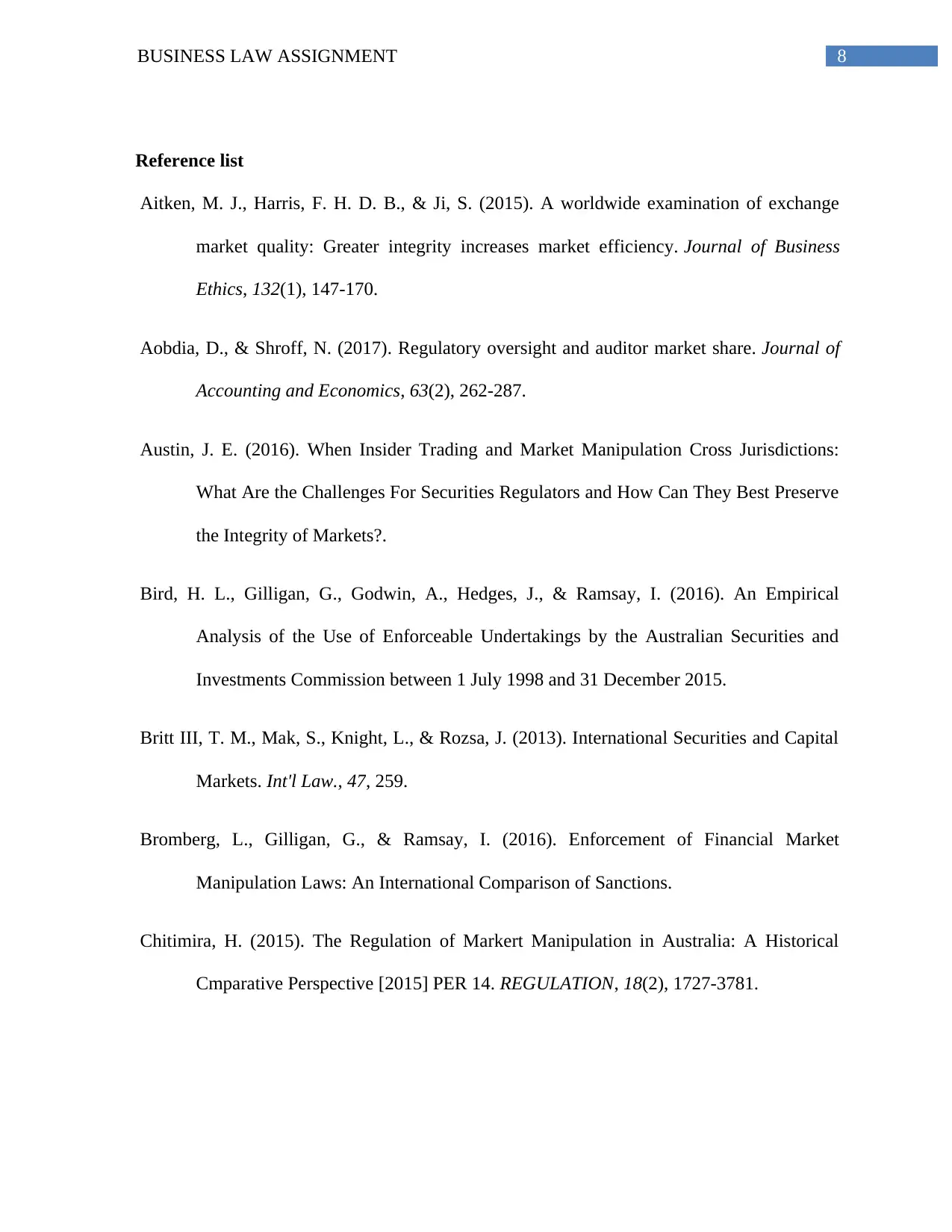
8BUSINESS LAW ASSIGNMENT
Reference list
Aitken, M. J., Harris, F. H. D. B., & Ji, S. (2015). A worldwide examination of exchange
market quality: Greater integrity increases market efficiency. Journal of Business
Ethics, 132(1), 147-170.
Aobdia, D., & Shroff, N. (2017). Regulatory oversight and auditor market share. Journal of
Accounting and Economics, 63(2), 262-287.
Austin, J. E. (2016). When Insider Trading and Market Manipulation Cross Jurisdictions:
What Are the Challenges For Securities Regulators and How Can They Best Preserve
the Integrity of Markets?.
Bird, H. L., Gilligan, G., Godwin, A., Hedges, J., & Ramsay, I. (2016). An Empirical
Analysis of the Use of Enforceable Undertakings by the Australian Securities and
Investments Commission between 1 July 1998 and 31 December 2015.
Britt III, T. M., Mak, S., Knight, L., & Rozsa, J. (2013). International Securities and Capital
Markets. Int'l Law., 47, 259.
Bromberg, L., Gilligan, G., & Ramsay, I. (2016). Enforcement of Financial Market
Manipulation Laws: An International Comparison of Sanctions.
Chitimira, H. (2015). The Regulation of Markert Manipulation in Australia: A Historical
Cmparative Perspective [2015] PER 14. REGULATION, 18(2), 1727-3781.
Reference list
Aitken, M. J., Harris, F. H. D. B., & Ji, S. (2015). A worldwide examination of exchange
market quality: Greater integrity increases market efficiency. Journal of Business
Ethics, 132(1), 147-170.
Aobdia, D., & Shroff, N. (2017). Regulatory oversight and auditor market share. Journal of
Accounting and Economics, 63(2), 262-287.
Austin, J. E. (2016). When Insider Trading and Market Manipulation Cross Jurisdictions:
What Are the Challenges For Securities Regulators and How Can They Best Preserve
the Integrity of Markets?.
Bird, H. L., Gilligan, G., Godwin, A., Hedges, J., & Ramsay, I. (2016). An Empirical
Analysis of the Use of Enforceable Undertakings by the Australian Securities and
Investments Commission between 1 July 1998 and 31 December 2015.
Britt III, T. M., Mak, S., Knight, L., & Rozsa, J. (2013). International Securities and Capital
Markets. Int'l Law., 47, 259.
Bromberg, L., Gilligan, G., & Ramsay, I. (2016). Enforcement of Financial Market
Manipulation Laws: An International Comparison of Sanctions.
Chitimira, H. (2015). The Regulation of Markert Manipulation in Australia: A Historical
Cmparative Perspective [2015] PER 14. REGULATION, 18(2), 1727-3781.
⊘ This is a preview!⊘
Do you want full access?
Subscribe today to unlock all pages.

Trusted by 1+ million students worldwide

9BUSINESS LAW ASSIGNMENT
Chitimira, H. (2015). The regulation of market manipulation in Australia: A historical
comparative perspective. PER: Potchefstroomse Elektroniese Regsblad, 18(2), 112-
148.
Coffee Jr, J. C., Sale, H., & Henderson, M. T. (2015). Securities regulation: Cases and
materials.
Corporations Act 2001 (Cth)
Cumming, D., Dannhauser, R., & Johan, S. (2015). Financial market misconduct and agency
conflicts: A synthesis and future directions. Journal of Corporate Finance, 34, 150-
168.
Cumming, D., Dannhauser, R., & Johan, S. (2015). Financial market misconduct and agency
conflicts: A synthesis and future directions. Journal of Corporate Finance, 34, 150-
168.
FAME DECORATOR AGENCIES PTY LIMITED v JEFFRIES INDUSTRIES LTD &
ORS, Supreme Court of New South Wales, Court of Appeal, [08 May 1998]
French, D., Mayson, S., Mayson, S. W., & Ryan, C. (2014). Mayson, French & Ryan on
company law. Oxford University Press, USA.
Gitman, L. J., Juchau, R., & Flanagan, J. (2015). Principles of managerial finance. Pearson
Higher Education AU.
Grinblatt, M., & Titman, S. (2016). Financial markets & corporate strategy.
Hannigan, B. (2015). Company law. Oxford University Press, USA.
Chitimira, H. (2015). The regulation of market manipulation in Australia: A historical
comparative perspective. PER: Potchefstroomse Elektroniese Regsblad, 18(2), 112-
148.
Coffee Jr, J. C., Sale, H., & Henderson, M. T. (2015). Securities regulation: Cases and
materials.
Corporations Act 2001 (Cth)
Cumming, D., Dannhauser, R., & Johan, S. (2015). Financial market misconduct and agency
conflicts: A synthesis and future directions. Journal of Corporate Finance, 34, 150-
168.
Cumming, D., Dannhauser, R., & Johan, S. (2015). Financial market misconduct and agency
conflicts: A synthesis and future directions. Journal of Corporate Finance, 34, 150-
168.
FAME DECORATOR AGENCIES PTY LIMITED v JEFFRIES INDUSTRIES LTD &
ORS, Supreme Court of New South Wales, Court of Appeal, [08 May 1998]
French, D., Mayson, S., Mayson, S. W., & Ryan, C. (2014). Mayson, French & Ryan on
company law. Oxford University Press, USA.
Gitman, L. J., Juchau, R., & Flanagan, J. (2015). Principles of managerial finance. Pearson
Higher Education AU.
Grinblatt, M., & Titman, S. (2016). Financial markets & corporate strategy.
Hannigan, B. (2015). Company law. Oxford University Press, USA.
Paraphrase This Document
Need a fresh take? Get an instant paraphrase of this document with our AI Paraphraser
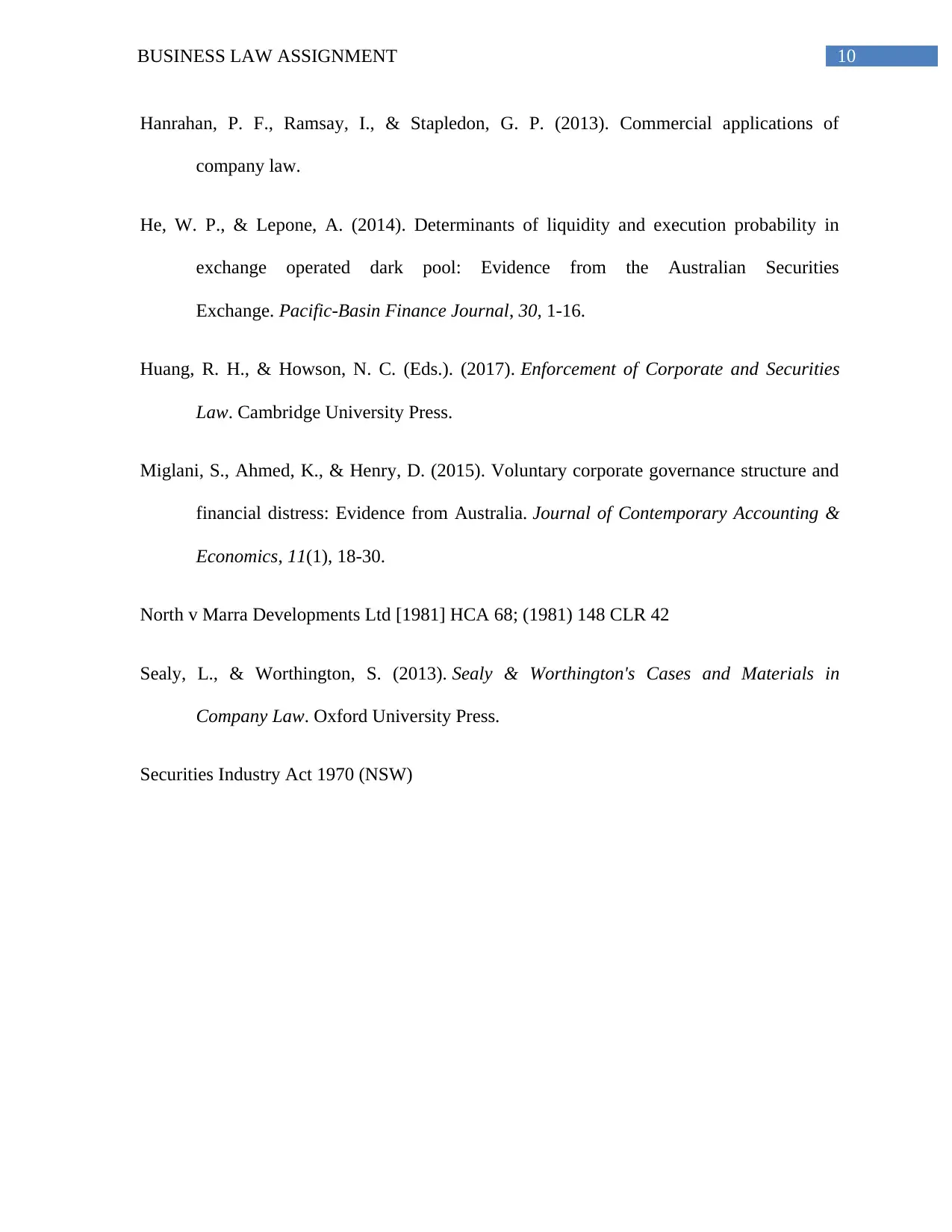
10BUSINESS LAW ASSIGNMENT
Hanrahan, P. F., Ramsay, I., & Stapledon, G. P. (2013). Commercial applications of
company law.
He, W. P., & Lepone, A. (2014). Determinants of liquidity and execution probability in
exchange operated dark pool: Evidence from the Australian Securities
Exchange. Pacific-Basin Finance Journal, 30, 1-16.
Huang, R. H., & Howson, N. C. (Eds.). (2017). Enforcement of Corporate and Securities
Law. Cambridge University Press.
Miglani, S., Ahmed, K., & Henry, D. (2015). Voluntary corporate governance structure and
financial distress: Evidence from Australia. Journal of Contemporary Accounting &
Economics, 11(1), 18-30.
North v Marra Developments Ltd [1981] HCA 68; (1981) 148 CLR 42
Sealy, L., & Worthington, S. (2013). Sealy & Worthington's Cases and Materials in
Company Law. Oxford University Press.
Securities Industry Act 1970 (NSW)
Hanrahan, P. F., Ramsay, I., & Stapledon, G. P. (2013). Commercial applications of
company law.
He, W. P., & Lepone, A. (2014). Determinants of liquidity and execution probability in
exchange operated dark pool: Evidence from the Australian Securities
Exchange. Pacific-Basin Finance Journal, 30, 1-16.
Huang, R. H., & Howson, N. C. (Eds.). (2017). Enforcement of Corporate and Securities
Law. Cambridge University Press.
Miglani, S., Ahmed, K., & Henry, D. (2015). Voluntary corporate governance structure and
financial distress: Evidence from Australia. Journal of Contemporary Accounting &
Economics, 11(1), 18-30.
North v Marra Developments Ltd [1981] HCA 68; (1981) 148 CLR 42
Sealy, L., & Worthington, S. (2013). Sealy & Worthington's Cases and Materials in
Company Law. Oxford University Press.
Securities Industry Act 1970 (NSW)
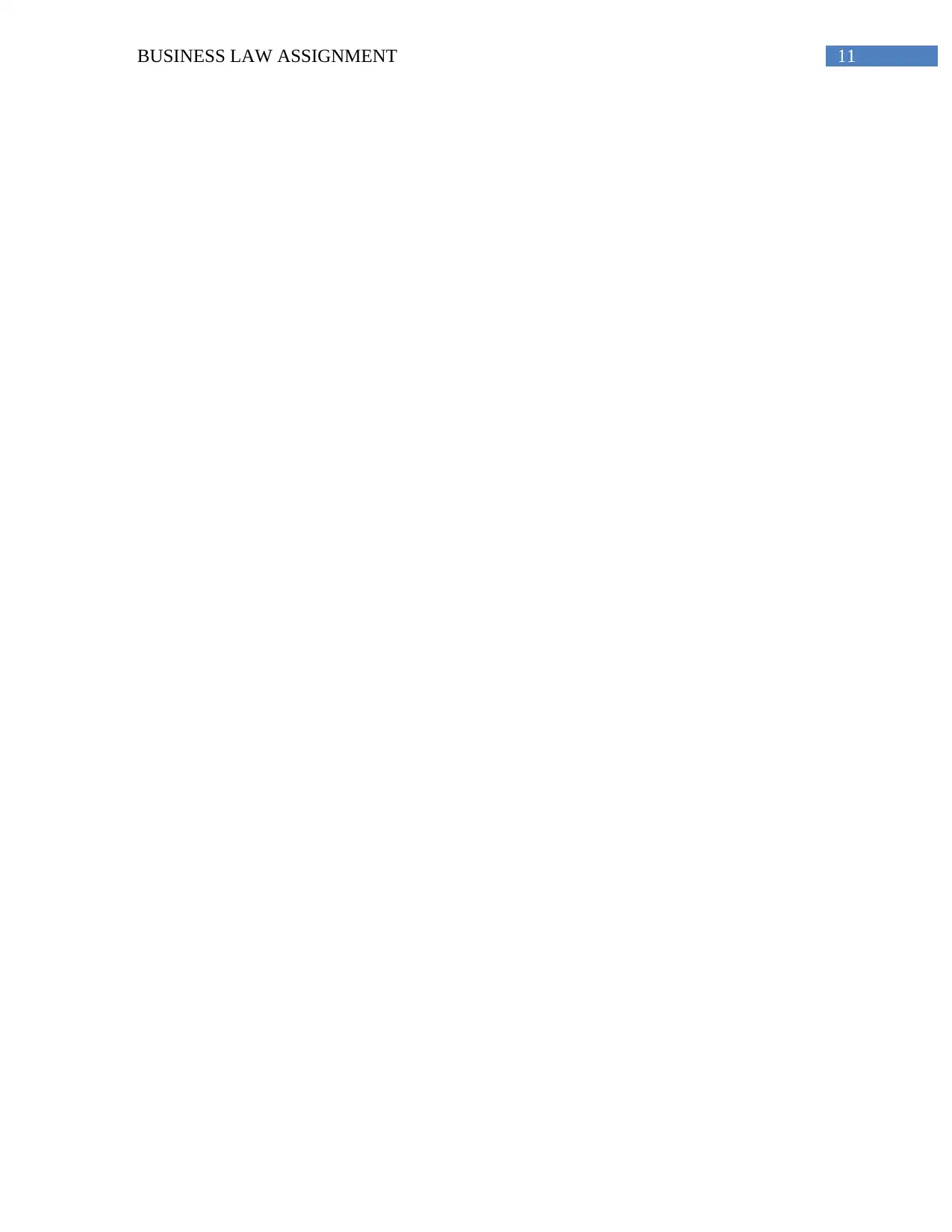
11BUSINESS LAW ASSIGNMENT
⊘ This is a preview!⊘
Do you want full access?
Subscribe today to unlock all pages.

Trusted by 1+ million students worldwide
1 out of 12
Related Documents
Your All-in-One AI-Powered Toolkit for Academic Success.
+13062052269
info@desklib.com
Available 24*7 on WhatsApp / Email
![[object Object]](/_next/static/media/star-bottom.7253800d.svg)
Unlock your academic potential
Copyright © 2020–2025 A2Z Services. All Rights Reserved. Developed and managed by ZUCOL.





